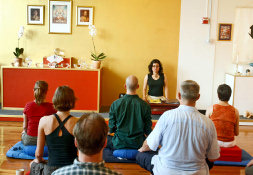 It is Sunday morning and about a dozen people have gathered at the Shambhala Meditation Center of Providence, a new Buddhist center on the Providence-Pawtucket line.
It is Sunday morning and about a dozen people have gathered at the Shambhala Meditation Center of Providence, a new Buddhist center on the Providence-Pawtucket line.
They convene in the shrine room, a bright open space with oak floors, and chant for about 15 minutes in English, as the leader punctuates the prayers with the sound of a bowl gong. Then silence, as the group settles into their cushions and begins to meditate. The only sound now is the hum of two straining air conditioners.
The center, part of a worldwide chain of such facilities, has been open for just about a year now, offering classes, open meditation sessions and free instruction for beginners. Stop by the center on Sunday mornings from 10 to noon and you can receive meditation instruction from one of the teachers. Or you can sign up for a five-week course called “Meditation in Every Day Life,” which will offer practical tips on how to work a meditation routine into busy lives. That course begins Tuesday at 7 p.m.
Teacher Douglas Anderson will cover the basics of meditation during the first session, then work with students on things that tend to get in the way of productive meditation sessions, things like fatigue, depression and distractions.
“Your experience on the cushion can’t be separated from your experience at work or any other place,” said Anderson.
You don’t have to be a Buddhist to sign up, or to benefit from a regular sitting practice. Most people at the center do consider themselves Shambhala Buddhists, however, a sort of amalgam of the traditional Tibetan Buddhist path and the Shambhala teachings espoused by the late Chogyam Tungpa, perhaps the most influential Tibetan teacher in the West.
The Shambhala teachings, which have been around since the time of the Buddha, closely parallel the Tibetan Buddhist path, but without the religious trappings. Trungpa wrote about the Shambhala teachings with the hope of making Buddhist principles more palatable to Westerners, said Mitchell Levy, a senior teacher in the Shambhala community.
But after Trungpa’s death, his son, Sakyong Mipham Rinpoche, decided to combine the two paths into a single approach, now known as Shambhala Buddhism.
But why meditate in the first place? Levy, a physician in charge of critical care at Rhode Island Hospital and the Miriam Hospital, said, surprisingly, that it’s not about attaining bliss. That’s just another trap, he said.
The goal of meditation is not to feel peaceful, although that may happen, but to bring about an “understanding of who we are,” said Levy, who has been meditating since 1971, when he met Trungpa.
“Meditation is an elegant, simple way to arouse our natural wakefulness,” said Levy. “It makes us more accepting of ourselves and others.”
Besides the Sunday meditation session, there is an open sit Wednesdays from 6 to 7:30 p.m. And there are meditation workshops on the second and fourth Mondays of the month designed for beginners.
“Meditation helps people work toward experiencing their natural wakefulness,” said Levy. “And you don’t have to be a Buddhist to do that.”
Source: The Providence Journal




